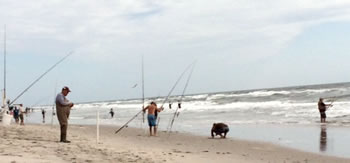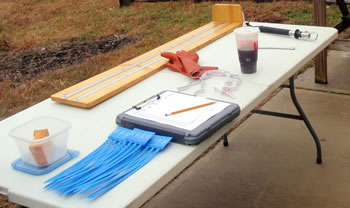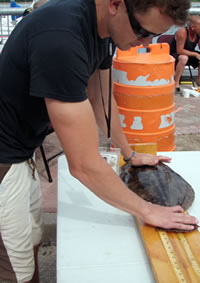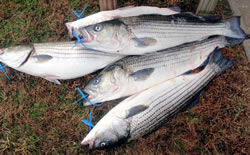  |
A Day At a Fishing Tournament |
|
by Shana Fehring, Hourly Fisheries Technician
Bureau of Marine Fisheries
December 21, 2017
Many anglers enjoy participating in fishing tournaments, organized competitions among recreational anglers pursuing specific species of fish. Fishing takes place either offshore from a boat or from a shoreline, around a clearly defined body of water with specific rules. Anglers compete for prizes based on the total weight or length of a given species of fish caught within a predetermined time. Tournaments are dependent on the opening and closing of fishing seasons. Therefore, they take place throughout the year.
|
The objective of Division Bureau of Marine Fisheries staff attending fishing tournaments is to collect length and weight measurements from various species of fish to help in age determination to contribute to a better understanding of each fish population. Striped bass are particularly unique in that scale samples can be collected in addition to length and weight. These scales are used to age the fish. An alternative sampling method is removing the ear bone, known as the otolith, from the fish. For this sampling method to take place the fish species must be harvested. Thus, using the methods motioned above, biologists can create an age-length frequency key. (See A Day in the Chem Lab: Aging Weakfish, Atlantic Croaker, and American Eels.)
There are two types of tournaments Marine Fisheries staff attend: surf fishing and offshore tournaments. Each tournament has its own location for anglers to meet and have their fish judged. Most offshore fishing tournaments designate a marina or bait and tackle shop to weigh their catch. Surf fishing tournaments have judges located on site to record the anglers catch.
|
|
|
|
When scheduled to sample at a fishing tournament, I arrive at the Nacote Creek Nacote Creek Research Station early enough to reach my destination and set up equipment and materials. One or two other employees are scheduled along with me. We load up our assigned vehicle with the tournament supply bucket, a 48-inch measuring board, a folding table and a cooler with ice. The tournament supply bucket itself contains all the smaller materials that we will need while sampling: plastic bags, BogaGrip, clipboard with sampling data sheets, scale sample envelopes, numbered tags, heavyweight gloves, and more.
Before leaving, a call is made to the tournament coordinator to confirm the weigh-in location and time.
Once we arrive, I first seek out the tournament coordinator to get more details on where to set up our sampling materials. During offshore tournaments, we are frequently given permission to collect samples near the official tournament weigh-in scale. Surf fishing tournaments are a different story. Anglers are spread out blocks-wide along the beaches. Therefore, we will walk along the beach to collect data. Once all information is known about our set up location we collaborate to set up our materials and discuss who will be recording data and who will be measuring fish. Species predominantly sampled are striped bass, fluke, weakfish, bluefish and black sea bass.
|
|
When anglers are finished with their official tournament weigh-in, I kindly approach them explaining who we are, what our goals are and ask if they would allow us to weigh, measure and take samples from their catch. If they accept, I weigh their fish using our BogaGrip, measure the fork and total length of the fish, and provide the data to the recorder. For striped bass, I use a butter knife to take a scale sample and place it in the scale sample envelope.
If the angler is filleting their catch on site, I ask if they would like to donate the rack or head for ageing purposes. We gratefully accept all donated species. If they are willing to donate, I put one of our numbered tags through the gills and out the mouth of the fish and secure it tightly. I tell my recorder the number on the tag so they can match it up to the correct fish measurements. After the fish is filleted, I either take the whole rack or head sample and place it in a plastic bag which is then placed on ice in the cooler. A small paper tag also accompanies the head sample providing the date, species, and tournament the sample was collected from.
This process is continued throughout the duration of the weigh-in. When the weigh-in is complete I express my gratitude to the tournament coordinator, pack the vehicle and head back to our field station.
Once I arrive back at Nacote Creek, I unpack the vehicle. Dirty supplies are taken to the wet lab to be cleaned and dried. Any samples collected that need to be frozen for otolith extraction are placed in the freezer located in the wet lab. All scale sample envelopes are collected and placed in the ageing lab for future examination. The supply bucket and the data sheets are returned to the office. /font>
|
|
|
|
Tournaments are especially valuable in supplementing data to Marine Fisheries' field surveys due to the opportunity for otolith collection. The otolith is the most accurate way to age a fish. Since fish entered in tournaments are all harvested, this is the favored sampling method for collecting otoliths. Knowing the age of individual fish plays an important role in future fisheries management.
Using the scientific data collected at tournaments, the Bureau Marine Fisheries develops fishing regulations (in concert with federal guidelines). In order to prevent overfishing and rebuild overfished stocks, regulations are put in place to maintain healthy and sustainable fisheries for future generations. These regulations are what make fishing tournaments possible!
|
Back to A Day In the Life Of a Marine Fisheries Hourly
|




